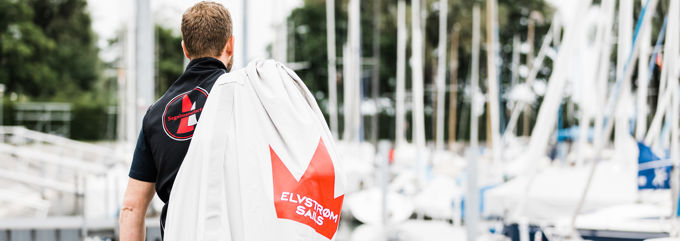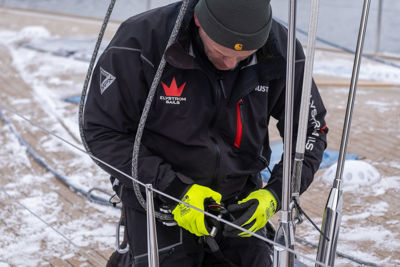
Staying on top of maintenance is as important on sails as it is on your car or house. Well maintained and kept sails will perform better for longer – and more vitally, a well-kept sail will give you more peace of mind every time you set sails and use it.
Generally speaking, sail maintenance is best done in the autumn before packing everything away for the winter.
A proper preparation before storage can save you much hassle in the long run. Clean and dry sails are key here - if the sails are left with salt or moisture all winter long, chances are that you'll get an unpleasant surprise in the spring.
And if your sails need more extensive service, it is always a good choice to get it done at the end of the season. Sailmakers are always at the start of the season.

The two sides of the coin
Sail maintenance is a big segment, but it can practically be split up in to two areas. One is the constant maintenance and the small tricks you can use every day through the season – and the other is what you should note and take care of before and during winter storage.
On the water
When the sails are in use through the season, your small actions and tips can make a big difference for the longevity of your sail and indeed its performance.
The two arch enemies of sails are ultraviolet light and salt.
This is where your daily routine really comes into play. You can make a big difference here, given that you manage your sails correctly. Also, keeping a sail clean will make a big difference in keeping the original properties of the sail.
1. Do always use a cover on the sails when they’re not in use. We make a wide range of covers such as boomcovers, furlcovers and zippacks – all of them are made with the all-important purpose of shielding your sails from the UV from the sun.
2. If you have a furling sail, its usually equipped with a built-in UV protection. Make sure to furl your sail the right way around – the UV must be on the outside when furled – otherwise it won’t make a difference! The part, which is often just referred to as the UV, is there to shield the sail material itself from UV-related damage. The UV is made to take the damage, and at the end of the day it’s much cheaper to replace a worn out UV than a worn out sail.
3. Avoid impact – if possible, make sure to take down the sails in calm conditions. It cannot always be avoided but try to minimize the time where the sails flap or flog around when being put up or taken down.
Excessive flogging can in the long run lead to damage – especially when combined with UV degradation and warm weather. This phenomenon is also known as flex fatigue, simply meaning that your sail will become vulnerable to damage at some point when the fabric has been hitting back and forth.
4. If possible, give your sails a clean with fresh water every now and then. Salt has a strong hydroscopic effect, meaning that salt water dries much slower than fresh water. This can cause issues if wet sails are packed or furled – and over time, salt can also make further damage to the hardware.
5. Following #4, make sure that you never leave wet sails packed or furled for more than a day or two. Do always make sure that they are dry before packing them for a longer period of time.
This works exactly the same way as you would never pack away a wet tent – it will turn moldy and stale over time, and that’s neither a pleasant look, smell or feel!

Winter Storage (winter check)
The other part of good sail care and maintenance is the storage.
Just as important as dry packing is in the shorter term, it also becomes vital when storing your sails for the winter. Mildew can quickly form in moist conditions – and once its there, its hard to get rid of.
So try to avoid getting the problem. This is done by ensuring that your sails are salt-free when you prepare for storage. Rinse the salt off first using fresh water and make sure the sails are fully dry before you proceed.
You should by any means store the sails dry and in an ideally well ventilated room at around room temperature.
1. The best tip against mildew is to avoid getting it. Should it appear anyway, you can try cleaning it, but make sure to use the right method.
2. Cleaning mildew can be done using warm water and dishwashing liquid. Agitate the spot with a soft brush and try to clean the spot.
3. Do NEVER EVER use any chemical solvents or detergents. It may destroy the material integrity of the sail. Warranty is also void if chemicals are used on the sail, so this is just a pure no-go.
4. If a sail develops mildew, please ensure that it doesn’t spread. If one sail has mildew, make sure it is kept well away from other, clean sails.
5. It is also important that sails are stored when fully dry and clean.
Folding techniques
Creases are also nice to avoid – and the proper folding technique this should be a part of the routine no matter if you pack the sails after use or for storage.
EPEX sails should be rolled from top to foot, especially for winter storage. Other sail types are best kept folded or rolled. If you fold the sail, make sure to zig-zag it – this method makes sure that the sail will not get permanent creases.

Quick step by step guide
Avoid fluttering sails
Whenever you notice a fluttering leech, tighten the leech lines.
To avoid fluttering sails, reef in time.
Avoid creases
Make sure you either roll or fold your sail correctly (Zig-Zag). Ideally an EPEX sail should be rolled from the top to foot, when going in to winter storage. This will prevent permanent creases.
Use patches
Wherever your sail may touch parts of the boat, like spreaders, reelings, pulpits, radars, etc, use patches to protect your sail from unnecessary friction.
Always use cover
Always use cover when mooring. We offer a range of products which are very comfortable to handle, i.e. Boomcovers, Furlcovers or ZipPacks.
UV cover
Furling headsails are usually equipped with UV-Protection. Make sure you furl your sail right. The UV cover has to be on the outside!
Avoid UV impact
Take down your sails in calm conditions to avoid damage. The mix of boiling heat and flapping can cause damage.
Avoid mildew
Never leave your wet sails furled or packed for more than a few days. Moisture will cause mildew and that can be very hard to clean. Whenever you have the chance, wash your sail with sweet water and dry out. Salt water has a strong hygroscopic effect and hardly dries at all.
Correct Cleaning
Use warm water or lemon solvent to clean your sail.
You can get rid of most stains by using a soft brush. Never use any chemical solvents or detergents because they may destroy the material integrity of your sail!
Winter Service
Hand in your sails for an annual service check. Our SailPoints offer a range of winter services and repairs to extend the life span of your sails. Some also offer winter storage.
